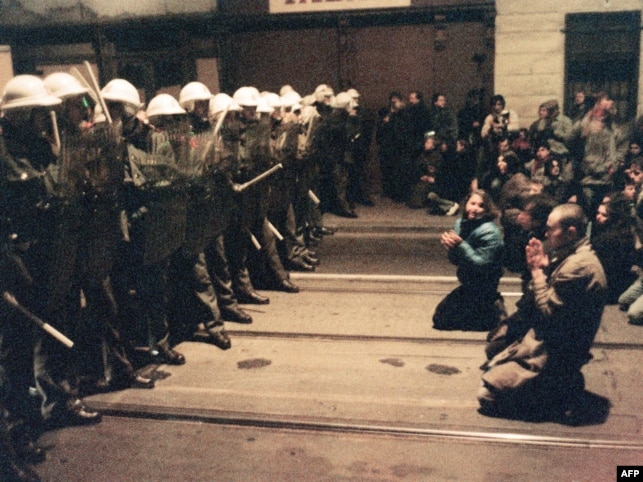Unraveling The Šmid Death Story

Timothy Garton Ash, reviewing several books on 1989 for the New York Review of Books, wrote that “An erroneous report on Radio Free Europe (RFE) that a student called Martin Šmid had been killed, in the suppression of the November 17, 1989, student demonstration in Prague, helped to swell the protesting crowds in the first days of the Velvet Revolution in Czechoslovakia.”
Michael Nelson, veteran Reuters correspondent and executive, recounting the background to the story in his book, War of the Black Heavens (Syracuse University Press, 1997, pp. 184-186), concluded that the report on RFE and VOA “started a sequence of events that eventually brought down the communist government.”
What happened?
RFE research reported the following on November 17:
“An authorized rally in Prague, attended by some 50,000 people, to commemorate the death of Czech student Jan Opletal 50 years ago at the hands of the Nazis, turned into a pro-democracy and anti-government demonstration. Police riot troops responded with unprecedented violence. According to official Czechoslovak sources, 17 people were injured, and 143 protesters, including Prague Spring leader Alexander Dubcek, were arrested.”
The next day, November 18, “Actors and students called for a one-week boycott of all theater performances and university classes and urged a two-hour general strike on November 27 to protest police brutality in Prague on November 17. The official Czechoslovak dailies Lidova Demokracie and Mlada Fronta criticized riot police and paratroopers who smashed the November 17 demonstration. Some 2,000 people were forced to disperse by police in Prague after gathering and laying flowers at the site where demonstrators were beaten during the November 17 demonstration.”

Martin Šmid, a student activist whose “death” helped spark the Velvet Revolution, is pictured here in a 2003 photo.
Covering these dramatic developments based on information it received from Western media accounts and its own sources in Prague, the RFE Czechoslovak Service, headed by Pavel Pechacek, received a report that Šmid had been killed during the November 17 demonstration from Peter Uhl, a Charter 77 activist who ran an underground “press agency” that had a good record for reliability. Uhl passed on the report to other Western media, including Reuters’ Prague correspondent Michael Zantovsky. Reuters ran the story, as did VOA. RFE/RL had a firm two-source requirement for news like this, and it held the story while seeking confirmation.
We were suspicious about the timing, given the 50th anniversary of Opletal’s funeral. Pechacek and his colleagues phoned around Prague seeking, and eventually locating a second source. On November 18, RFE broadcast the story of Šmid’s death. As it turned out, Šmid was in fact alive and soon returned home. His identity card had been seized by the police a day or two earlier when he participated in another demonstration.
Several conclusions follow:
- RFE/RL practiced sound, professional journalism. It did its best to get the story right, rather than first. It nonetheless inadvertently broadcast a false report. As the dominant broadcaster in Czechoslovakia at the time, it is understandable that reporting errors would be attributed to RFE, when other broadcasters also made mistakes.
- The genesis of the “Šmid death story” remains unclear to this day. A commission established by then-President Havel was unable to find conclusive evidence of exactly where the story had come from, pinning the ultimate blame on “unbalanced individuals.” In truth, the report could be attributed to innocent miscommunication in the confusion of police violence.
- It was only through RFE/RL, VOA, and other Western media that Czechoslovaks heard the story. Many participants and observers agree that the reporting contributed to galvanizing a population already aroused by the flood of East Germans into the West German embassy in Prague, the Polish elections, the breaching of the Iron Curtain in Hungary, the fall of the Berlin Wall, and by the police violence of November 17. The report is also widely credited with leading to the large demonstrations on November 22 that ultimately resulted in the Velvet Revolution.

Hundreds of Czechoslovakian students kneel as they face riot police on 19 Nov 1989 in downtown Prague during a protest rally asking for more democracy and demanding the end of Communist rule.
But there was a context. RFE broadcasts to Czechoslovakia had comprehensively covered the increasing ferment and wave of demonstrations in that country prior to and after November 17. Pavel Pechacek (thanks to inadvertence in granting him a visa by an evidently disintegrating secret police apparatus) was able to provide measured, professional reporting from Wenceslas Square during the first days of massive demonstrations when Czechoslovak television and radio were still censored.
— A. Ross Johnson
Former Director, Radio Free Europe
With contributions from Robert Gillette, Pavel Pechacek, and Richard Cummings